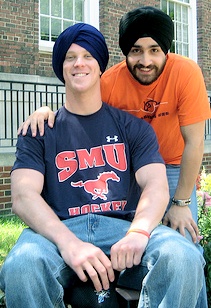Template:AOW199: Difference between revisions
Hari singh (talk | contribs) No edit summary |
Hari singh (talk | contribs) No edit summary |
||
| Line 2: | Line 2: | ||
{{p|Image:International Turban Day-3.jpg|Volunteer and organiser show off their turbans}} | {{p|Image:International Turban Day-3.jpg|Volunteer and organiser show off their turbans}} | ||
'''International Turban Day''' is celebrated on April 13th every year. This event was started in 2004 to bring awareness of the strict requirement on [[Sikh]]s to don the [[turban]] as a mandatory part of their religion. | '''International Turban Day''' is celebrated on April 13th every year. This event was started in 2004 to bring awareness of the strict requirement on [[Sikh]]s to don the [[turban]] as a mandatory part of their religion. In the West since {{w|9/11}} in 2001, the [[turban]], has attracted negative attention due to the wrongful linking of this garment with {{w|Osama bin Laden}}, the Muslim leader of al Qaeda who has often been pictured wearing a turban. | ||
Due to the vast news coverage of Osama bin Laden following 9/11, | Due to the vast news and media coverage of Osama bin Laden following 9/11, many men wearing a turban and beard and [[Punjabi]] styled clothing articles (long vest or longer shirt) have been looked upon with suspicion, with some innocent people even being killed or wounded by uninformed and even deranged westerners bent on revenge, who just assumed that any Bearded man, wearing a turban and beard was a [[Muslim]]. | ||
However, this perception is wrong, as the vast majority of people in Western countries who wear turbans are actually [[Sikh]]s. Given that many thousands of Sikhs died fighting against the same sort of [[Muslim]] fundamentalist terrorists that bin Laden's group al Qaeda and the taleban espouse today, the irony of such an uninformed assumption is tragic, especially since most Muslims living in the West do not wear turbans. | |||
The turban or "dastar" or "pagri" often shortened to "pag" are different words in various dialects for the same article. All these words refer to the garment worn by both men and some women to cover their heads. It is a headdress consisting of a long scarf-like single piece of cloth wound round the head or sometimes an inner "hat" or [[patka]]. {{aowf|Turban day}} | |||
Revision as of 18:56, 1 April 2009
International Turban Day is celebrated on April 13th every year. This event was started in 2004 to bring awareness of the strict requirement on Sikhs to don the turban as a mandatory part of their religion. In the West since 9/11 in 2001, the turban, has attracted negative attention due to the wrongful linking of this garment with Osama bin Laden, the Muslim leader of al Qaeda who has often been pictured wearing a turban.
Due to the vast news and media coverage of Osama bin Laden following 9/11, many men wearing a turban and beard and Punjabi styled clothing articles (long vest or longer shirt) have been looked upon with suspicion, with some innocent people even being killed or wounded by uninformed and even deranged westerners bent on revenge, who just assumed that any Bearded man, wearing a turban and beard was a Muslim.
However, this perception is wrong, as the vast majority of people in Western countries who wear turbans are actually Sikhs. Given that many thousands of Sikhs died fighting against the same sort of Muslim fundamentalist terrorists that bin Laden's group al Qaeda and the taleban espouse today, the irony of such an uninformed assumption is tragic, especially since most Muslims living in the West do not wear turbans.
The turban or "dastar" or "pagri" often shortened to "pag" are different words in various dialects for the same article. All these words refer to the garment worn by both men and some women to cover their heads. It is a headdress consisting of a long scarf-like single piece of cloth wound round the head or sometimes an inner "hat" or patka. .....More

